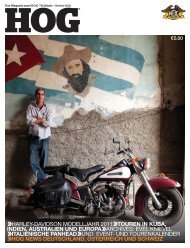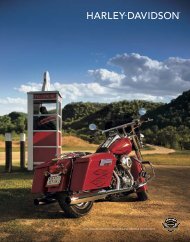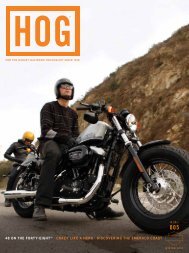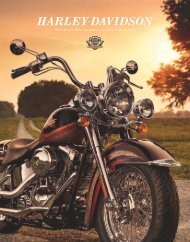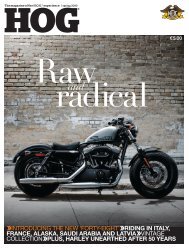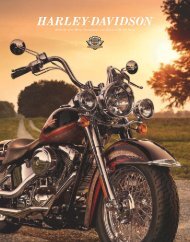0 0 8 custom alchemy for 2011 riding the beat in ... - Harley-News
0 0 8 custom alchemy for 2011 riding the beat in ... - Harley-News
0 0 8 custom alchemy for 2011 riding the beat in ... - Harley-News
You also want an ePaper? Increase the reach of your titles
YUMPU automatically turns print PDFs into web optimized ePapers that Google loves.
Archives<br />
Photograph courtesy of <strong>the</strong><br />
<strong>Harley</strong>-Davidson Motor Company<br />
Archives. Copyright H-D. ®<br />
Military Metal<br />
<strong>Harley</strong>-Davidson has a long history of support<strong>in</strong>g<br />
<strong>the</strong> military, with both <strong>the</strong> products it has supplied and <strong>in</strong> <strong>the</strong><br />
o<strong>the</strong>r ways it has shown appreciation over <strong>the</strong> years.<br />
The first official U.S. military order <strong>for</strong> <strong>Harley</strong>-Davidson®<br />
motorcycles dates all <strong>the</strong> way back to 1916, when <strong>the</strong> U.S.<br />
Mexican Border Conflict pitted Mexican revolutionary<br />
Pancho Villa and his raiders aga<strong>in</strong>st General John “Blackjack”<br />
Persh<strong>in</strong>g and <strong>the</strong> U.S. Army. Persh<strong>in</strong>g believed <strong>in</strong> us<strong>in</strong>g<br />
modern technology – automobiles, airplanes, telegraphy, and<br />
motorcycles – to give <strong>the</strong> Americans <strong>the</strong> advantage. The <strong>in</strong>itial<br />
request <strong>for</strong> 12 bikes, later expanded to a grand total of 24,<br />
<strong>in</strong>cluded bikes attached to a sidecar gun carriage, <strong>in</strong>vented<br />
by none o<strong>the</strong>r than co-founder William S. <strong>Harley</strong>.<br />
When <strong>the</strong> U.S. entered World War I, <strong>Harley</strong>-Davidson’s<br />
production ramped up aggressively to meet <strong>the</strong> demand.<br />
Approximately one-third of all bikes made over <strong>the</strong> course of<br />
1917 and 1918 were purchased <strong>for</strong> use <strong>in</strong> <strong>the</strong> war. While <strong>the</strong><br />
first bikes shipped were adapted civilian models, H-D quickly<br />
developed <strong>the</strong> FUS and LUS models with <strong>the</strong> trademark high,<br />
flat fenders <strong>for</strong> muddy conditions and o<strong>the</strong>r military-friendly<br />
features. On November 12, 1918, one day after <strong>the</strong> armistice,<br />
<strong>the</strong> very first American to set foot <strong>in</strong> Germany was <strong>rid<strong>in</strong>g</strong> a<br />
<strong>Harley</strong>‐Davidson (see Pages 8-9).<br />
By this time, military leaders realized <strong>the</strong> motorcycle was not<br />
a pure combat vehicle, but it would soldier on as a courier and<br />
escort mount. It was also dur<strong>in</strong>g <strong>the</strong> Great War that <strong>the</strong> Motor<br />
Company’s “Quartermaster School” – which exists today as<br />
<strong>Harley</strong>-Davidson University – began tra<strong>in</strong><strong>in</strong>g Army mechanics.<br />
Development of motorcycles <strong>for</strong> <strong>the</strong> military did not stop<br />
between <strong>the</strong> two World Wars. Company documents from <strong>the</strong><br />
1930s mention <strong>the</strong> development of a three-wheeled vehicle with<br />
an opposed tw<strong>in</strong> eng<strong>in</strong>e under development. It’s not known if<br />
that eng<strong>in</strong>e ultimately became <strong>the</strong> XA of World War II years.<br />
Only about 1,100 of <strong>the</strong> XA bikes, with opposed cyl<strong>in</strong>ders<br />
and a shaft drive, were built and shipped be<strong>for</strong>e <strong>the</strong> U.S.<br />
government canceled <strong>the</strong> contract. But it did give rise to <strong>the</strong><br />
experimental XS, a sidecar version featur<strong>in</strong>g a driven sidecar<br />
wheel. O<strong>the</strong>r experimental side projects <strong>in</strong>cluded an eng<strong>in</strong>e <strong>for</strong><br />
a “m<strong>in</strong>i tank” to be built <strong>for</strong> <strong>the</strong> Canadian military, with two<br />
Knucklehead V-tw<strong>in</strong> eng<strong>in</strong>es work<strong>in</strong>g <strong>in</strong> tandem. Although<br />
this project never took hold, Canadian versions of <strong>the</strong> WLA<br />
(<strong>the</strong> WLC) were delivered.<br />
William S. <strong>Harley</strong> checks out <strong>the</strong> per<strong>for</strong>mance of motorcycles built <strong>for</strong><br />
World War I.<br />
The U.S. had already shipped motorcycles to <strong>the</strong> UK and Russia<br />
as part of <strong>the</strong> Lend-Lease Act of 1941, but after Pearl Harbor,<br />
military production soared to numbers <strong>in</strong> <strong>the</strong> tens of thousands.<br />
At war’s end, almost 70,000 WLA models, <strong>the</strong> workhorse of<br />
wartime American motorcycles, were <strong>in</strong> service. For its wartime<br />
ef<strong>for</strong>ts, H-D was awarded <strong>the</strong> Army-Navy “E” Award <strong>for</strong><br />
Excellence <strong>in</strong> Wartime Production three straight years.<br />
Motorcycle production <strong>for</strong> <strong>the</strong> military never aga<strong>in</strong> saw <strong>the</strong> levels<br />
of <strong>the</strong> 1940s. Military versions of <strong>the</strong> smaller Sportster® model were<br />
produced <strong>in</strong> <strong>the</strong> 1960s, and saw both police and military service <strong>in</strong><br />
nations <strong>in</strong>clud<strong>in</strong>g Vietnam and Indonesia.<br />
<strong>Harley</strong>-Davidson’s f<strong>in</strong>al military motorcycles were <strong>the</strong> MT-<br />
500 and lesser-known MT-350E. The MT-350E was produced <strong>in</strong><br />
<strong>the</strong> 1980s by Armstrong-CCM Motorcycles. When H-D acquired<br />
Armstrong’s military division, <strong>the</strong> MT-500 was already <strong>in</strong><br />
production. It orig<strong>in</strong>ally saw action <strong>in</strong> <strong>the</strong> Falkland Islands<br />
conflict (between Great Brita<strong>in</strong> and Argent<strong>in</strong>a), but later was<br />
built strictly <strong>for</strong> <strong>the</strong> militaries of Canada and Jordan.<br />
Today, <strong>Harley</strong>-Davidson cont<strong>in</strong>ues to support groups and<br />
programs such as <strong>the</strong> Disabled American Veterans, Roll<strong>in</strong>g<br />
Thunder® motorcycle rally, Veterans of Foreign Wars (<strong>for</strong> <strong>the</strong><br />
National World War II Memorial), The Vietnam Travel<strong>in</strong>g Memorial<br />
Wall,® and many more. It’s a history of which <strong>the</strong> Motor Company<br />
is very proud – but not as proud as we are of all <strong>the</strong> f<strong>in</strong>e military<br />
men and women who have served our great country.<br />
To see more historical items from <strong>the</strong> H-D Archives, visit <strong>the</strong><br />
<strong>Harley</strong>-Davidson Museum® <strong>in</strong> Milwaukee. www.h-dmuseum.com<br />
64 HOG



